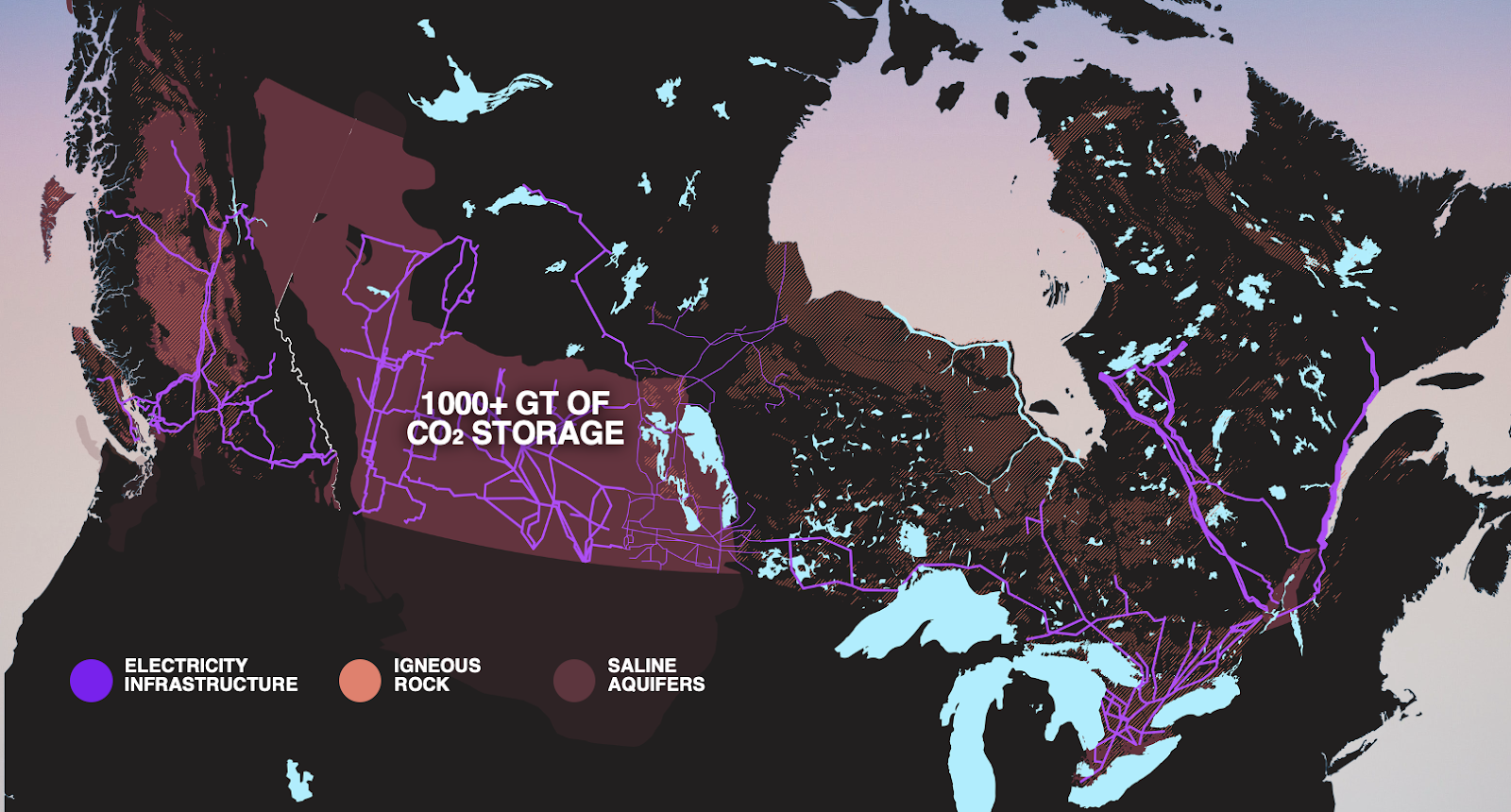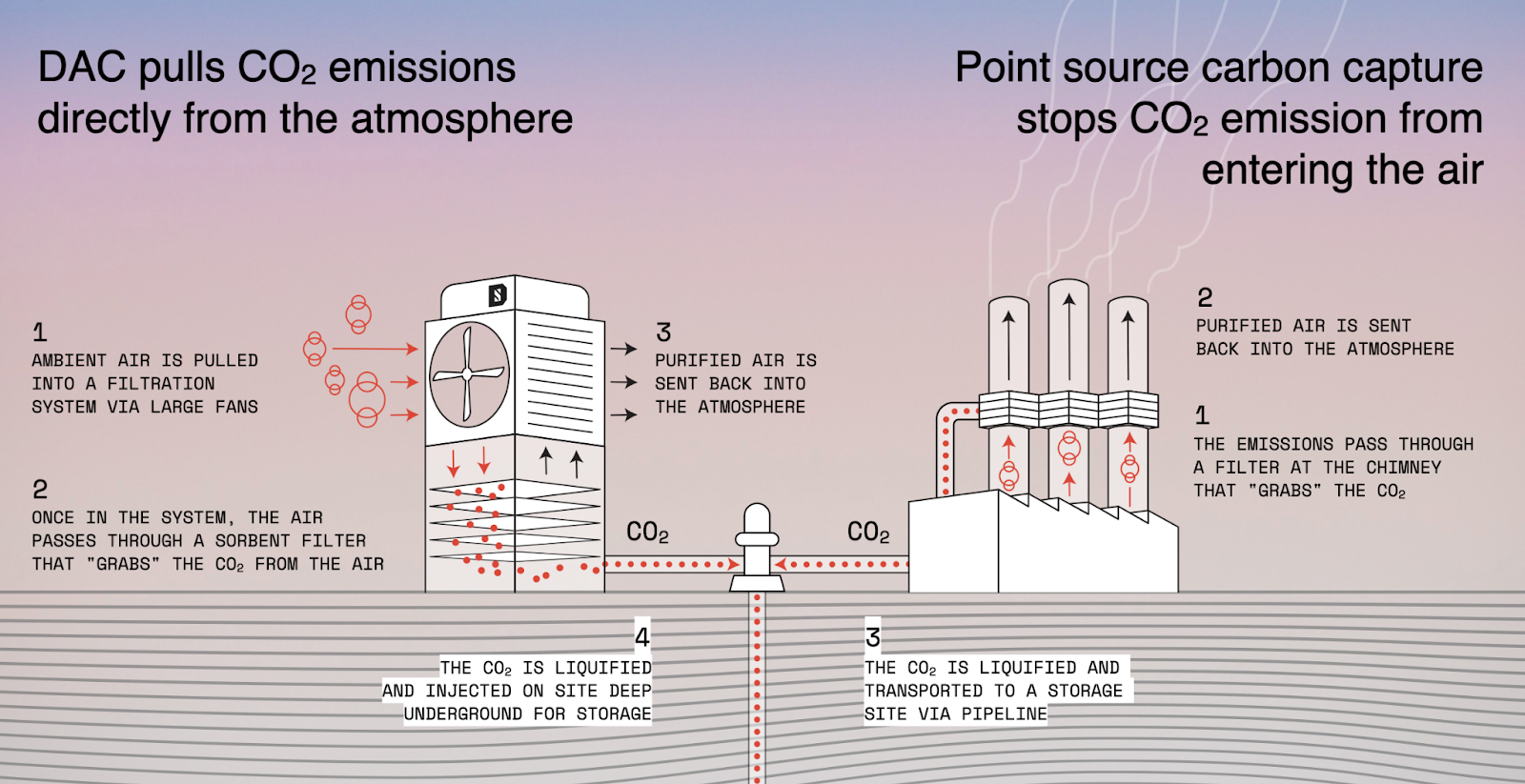DeepDives is a bi-weekly essay series exploring key issues related to the economy. The goal of the series is to provide Hub readers with original analysis of the economic trends and ideas that are shaping this high-stakes moment for Canadian productivity, prosperity, and economic well-being. The series features the writing of leading academics, area experts, and policy practitioners. This DeepDives essay was commissioned by The Hub. Deep Sky is a Hub advertiser.
The world has never been warmer, and this heat is scorching our communities and burning our economies. The wildfire that ravaged the picturesque community of Jasper, Alberta, this summer is estimated to cost the insurance industry $700 million alone. Research published earlier this year showed that within 25 years, climate change will cause $38 trillion in damages annually to the global economy, a staggering amount equivalent to a third of today’s global gross domestic product. As the world continues to experience record-breaking temperatures that threaten lives and economies, innovative technologies are essential to limit the impacts of a changing climate while preserving our current standard of living.
This DeepDive examines one of those emerging technologies—direct air capture (DAC)—and assesses its opportunities and prospects for making meaningful progress in mitigating climate change.
The emergence of direct air capture technology
Imagine a future where we extract the carbon emissions that accelerate our warming atmosphere directly from the air. This isn’t science fiction; it’s the premise of DAC technology—an approach pioneered years ago by scientists such as Professor David Keith at the University of Calgary. At its core, DAC involves capturing carbon dioxide (CO2) directly from the air and permanently storing it underground, thereby reducing the overall concentration of carbon in the atmosphere. This makes intuitive sense—we got into this situation by taking carbon from underground and putting it into the air. To reverse the damage, we must take it out of the air and store it underground where we first found it.
DAC contrasts with traditional strategies that focus solely on reducing future emissions. While reducing emissions through approaches like industrial electrification, renewables, and sustainable aviation fuels remains the short-term priority to address climate change—as time goes on and we continue to miss our targets, the role of removing CO2 from the atmosphere becomes ever more important. While cutting emissions is essential, it is not enough to meet the net-zero targets set by global agreements like the Paris Accord. DAC bridges this gap by actively reducing the CO2 already present in our atmosphere. This dual approach—cutting emissions and removing existing CO2—is crucial for achieving net-zero emissions and stabilizing global temperatures. DAC is the “net” in net-zero.
The significance of DAC lies not only in its technical capabilities but also in its scalability and versatility. Unlike point-source carbon capture, which targets emissions from specific industrial processes, DAC addresses the cumulative emissions that have built up over decades, providing a solution that can be deployed virtually anywhere there is access to geologic storage and renewable power.
Beyond its environmental benefits, DAC represents a significant economic opportunity. A recent report by McKinsey & Company estimates that the market for durable carbon removals like DAC could be worth $1.2 trillion by 2050. The development and deployment of DAC technology can drive job creation, stimulate economic growth, and foster innovation across various sectors—it is not just a climate solution but also a catalyst for economic growth.
How does DAC work?
DAC works through a conceptually simple yet technologically sophisticated process. Large fans draw in ambient air, which is then passed through sorbents (either liquid or solid) that selectively bind to CO2 molecules. Think of a filter that is only selective to CO2 but lets the rest of the air (primarily nitrogen and oxygen) pass through. CO2 exists in the air at 421 parts per million in the atmosphere, or 0.042 percent, meaning you need to move one million molecules of air through a sorbent to capture 421 molecules of CO2. For context, in 2023, CO2 emissions reached a new record high of 37.4 billion tonnes. To remain below 1.5 degrees, we need to limit the amount of additional CO2 emissions to 250 billion tonnes—equivalent to approximately six years of our current emissions rate. Once captured, the CO2 is purified and can be stored underground in geological formations permanently, where it stays for hundreds to thousands of years.
There are over 100 different companies working to commercialize new approaches to direct air capture worldwide, with many startups being launched every day. Many of them were founded after the announcement of the $100M Carbon Removal XPRIZE competition in 2021. Each has its own approach to capturing CO2 from the air that differs in a few ways:
- The material sorbent that captures the CO2. Core to the DAC process is the “sorbent,” a liquid or solid material that selectively grabs onto CO2. You want a material that holds onto CO2, but not too strongly that it becomes difficult to remove—a Goldilocks zone of CO2 binding. The material also needs to be robust with a long lifetime, able to work in subzero freezing temperatures, and economical to mass manufacture.
- The way CO2 is removed from the sorbent. Once the sorbent is saturated, you need to find a way to remove the CO2, like squeezing a sponge. Some approaches heat up the sorbent to high temperatures, others expose it to steam, and some use electricity. Finding the most energy-efficient way of regenerating the sorbent material is critical to reducing the operating costs of the process. After the sorbent is empty, it can be used again to capture CO2 from the air.
- The process design and reactor engineering to make it all work. Every startup technology has a different reactor design, but the ideal reactor will be scalable, mass-manufacturable, modular, and also simple with few moving parts. The more steps and moving parts mean more potential failure points. Approaches that piggyback on existing industrial components in other industries like oil and gas or mining will typically have a better chance at scaling cost-effectively because precedents exist in other industries.
To make all this work, DAC needs to be 100 percent powered by low-carbon electricity including renewable energy, solar, wind, hydro-electricity, geothermal, and nuclear. It makes little sense to burn fossil fuels to produce energy just to capture CO2 from the atmosphere at far more dilute concentrations. Thankfully, Canadian electricity generation is currently 80 percent non-GHG emitting sources and has significant potential for low-carbon electricity across the nation with abundant hydro-electric power in Quebec, Manitoba, and British Columbia, solar and wind potential across Western Canada, and the potential emergence of small modular nuclear reactors—another technology area where Canada has an innovation advantage.
Once CO2 is captured from the atmosphere, it needs to be stored permanently and safely underground. Underground CO2 storage is an industrially mature process and has been done since the 1970s. In Canada, the Shell Quest Carbon Capture and Storage facility has been storing CO2 underground since 2015. Canada has some of the largest geologic formations to store CO2 in the world. Across Canada, there exist 389 billion tonnes of CO2 storage capacity alone, almost 600 times Canada’s total 2021 emissions.

Graphic credit: Carl Robichaud, director of design, Deep Sky.
The state of DAC projects worldwide
DAC projects are increasingly being implemented worldwide as part of the effort to mitigate climate change. Today there are 93 projects according to CDR.fyi, a public benefit corporation that monitors the carbon removal market and tracks announced and operational DAC projects worldwide. The majority of these projects are small-scale pilot projects that have barely made it out of a laboratory setting, but a few standout projects have emerged on a path to rapidly scale.
Notable among these is Occidental Petroleum’s plant in Texas, which represents one of the largest planned DAC facilities in the world. This project aims to capture up to 1 million tons of CO2 annually, which will then be utilized in enhanced oil recovery and ultimately sequestered underground. Occidental acquired Canadian direct air capture company Carbon Engineering for $1.1B last year, the startup that spun out of the University of Calgary over a decade ago. Construction for the first phase of this facility to remove 500,000 tons of CO2 annually is set currently underway and set to finish by 2025. This project has attracted significant private capital investment with a $550M investment from private equity firm Blackrock.
Another significant project is Climeworks’ Mammoth plant in Iceland, which is currently the world’s largest operational DAC facility. Mammoth is designed to capture 36,000 tons of CO2 per year, which is then mineralized and stored permanently in basalt rock formations underground. The unique volcanic rock in Iceland helps to more easily trap the CO2 underground where it turns into rock within a couple of years. In 2022, Climeworks raised $650M in an equity fundraising round to expand its operations and build more direct air capture facilities.
A few other DAC projects have recently been announced or started operations, including Heirloom which opened the first commercial DAC facility in the U.S. last year which removes up to 1,000 tons annually. In Canada, Deep Sky announced construction of its 3,000-ton-per-year DAC pilot and innovation centre, Deep Sky Labs in Innisfail Alberta, which is set to begin operations this winter.
How does DAC compare to point source carbon capture?
While DAC shares a common goal with other carbon management technologies—managing CO2 to mitigate climate change—it differs fundamentally in its approach and application.
Both DAC and carbon capture and storage (CCS) technologies aim to reduce atmospheric CO2 levels, but how they do this differs. DAC targets ambient CO2, focusing on the cumulative emissions that have built up over decades. In contrast, CCS aims to capture CO2 emissions at their source, such as power plants or industrial facilities, preventing them from entering the atmosphere in the first place.
Imagine our atmosphere is a bathtub, and CO2 is overflowing water. When your bathtub is overflowing you can do two things—first, you can turn off the tap, and second, you can bail water out of the tub. CCS and point source carbon capture is turning off the tap, reducing emissions before they can entire the atmosphere. DAC is bailing water out of the tub, removing emissions that are already wreaking havoc. Unfortunately, the rate of flow is too great and we are failing at turning off the top— – as time goes on, we have more and more water we need to bail out of the tub.

Graphic credit: Carl Robichaud, director of design, Deep Sky.
Furthermore, the scale and scope of implementation vary. DAC often involves large-scale projects requiring substantial infrastructure, such as expansive DAC plants that can be deployed in diverse locations. CCS, however, is typically integrated into existing industrial processes, focusing on capturing emissions at specific points within these systems.
While both DAC and CCS are essential tools in the climate mitigation toolbox, their differences underscore the need for a multifaceted approach to tackling climate change. By leveraging the strengths of both technologies, we can develop a more comprehensive strategy to stabilize global temperatures.
Who is buying carbon removal credits and why?
DAC companies make money by selling carbon removal credits, where large companies pay a price per tonne of CO2 to the DAC company to remove CO2 from the air. According to CDR.fyi, nearly 5 million tons of carbon removal credits were purchased over the past year. Microsoft alone accounted for more than 3.3 million tons of these purchases as part of its ambitious goal to become a carbon-negative company by 2030, which includes removing its historical emissions from the atmosphere.
Although the carbon removal industry is still in its infancy, early adopters are willing to take on significant risks to accelerate the development of these emerging technologies. Frontier, a $1 billion advanced market commitment fund, was established to purchase carbon removal credits from early-stage companies. Spearheaded by Stripe, Frontier has attracted notable backers, including Alphabet, Shopify, Meta, McKinsey, Autodesk, H&M, JP Morgan Chase, and Workday.
So, what drives these pioneering companies to invest so heavily in carbon removal credits?
Today’s leading purchasers of carbon removal credits are typically large multinational corporations from three key sectors: technology, business (such as banks and consulting firms), and heavy industry (including airlines and manufacturers). These companies share several common factors: growing pressure from stakeholders and customers to adopt sustainable practices, a need to stay competitive in talent acquisition and retention, particularly in tight labour markets, higher profit margins that enable action, and a substantial amount of emissions that are beyond their direct control.
For technology companies, operating data centres and servers demands enormous energy consumption, with the bulk of their emissions tied to electricity production. Building renewable energy infrastructure can be costly, and if their power grids rely on fossil fuels, these companies have limited options to meet their sustainability targets. In the banking sector, most emissions are tied to portfolio investments, leaving banks with little control over direct emissions reductions. Management consulting firms face similar challenges, as the majority of their emissions stem from travel, particularly air travel, which is still heavily dependent on fossil-based jet fuel. The airline industry is exploring a shift to sustainable aviation fuel made from biomass instead of fossil fuels, but this alternative remains expensive and its supply is not yet sufficient.
With limited options available to achieve their net-zero goals, many of these companies are turning to carbon removal credits, driving demand to unprecedented levels. Here are four key reasons why these companies are investing in this nascent market:
- Meeting net-zero targets: As pressure from governments, customers, and the public to decarbonize continues to grow, more companies are setting ambitious net-zero goals. Adopting green practices has become essential for maintaining competitiveness in the modern economy.
- Fostering industry growth: Early adopters are supporting carbon removal companies by purchasing credits to help stimulate the industry. Expanding the supply of these projects requires investment, and securing contracts provides the necessary confidence for investors.
- Ensuring future supply: Despite the surging demand for carbon removal credits, supply has yet to catch up, with many projects still in the early stages. Although over 5 million tons of credits have been sold, only 300,000 have been delivered to date. Companies are pre-purchasing credits now to secure future supply from projects that are not yet operational.
- Leveraging a market opportunity: As the carbon removal credit market evolves from business-to-business transactions to transparent market exchanges, the trading volume is expected to increase. This presents an opportunity to capitalize on the anticipated gap between supply and demand as climate change pressures intensify, driving companies and countries to accelerate emissions reductions.

A person holds solid calcium carbonate pellets that were formed by precipitating captured carbon dioxide at a direct air capture plant in Squamish, B.C., October 7, 2015. Darryl Dyck/The Canadian Press.
Integrating DAC into a comprehensive climate strategy
To truly grasp the potential of DAC, we must consider its role within a broader, multifaceted climate strategy. It’s not a silver bullet but rather a crucial piece of a complex puzzle, one of many tools to address climate change.
One of the most compelling aspects of DAC technology is its synergy with renewable energy sources. While renewables are vital for reducing emissions, they can’t address all sources, particularly those that are difficult to eliminate. DAC can provide a complementary solution by removing CO2 from the atmosphere, creating a balanced and sustainable approach to climate mitigation.
Effective policy frameworks are essential to scaling up DAC efforts. Governments play a pivotal role in supporting research, development, and deployment through incentives, subsidies, and regulations. Public-private partnerships can also drive progress, combining public funding for early-stage research with private investment for commercialization and large-scale deployment.
The integration of DAC technology into a comprehensive climate strategy also requires a shift in our mindset. We must move beyond viewing DAC as a last resort or a backup plan and recognize it as an essential component of our efforts to combat climate change. This shift in perspective is crucial for driving the investments, innovations, and policies needed to support the development and deployment of these technologies on a global scale.
Key takeaways: challenges and opportunities ahead
Despite its promise, DAC technology faces significant challenges that must be addressed to unlock its full potential. Scalability remains a major hurdle. Deploying DAC technologies at the scale needed to make a meaningful impact requires substantial investment in infrastructure and technology. McKinsey estimates that to reach net-zero, the DAC industry requires $6 trillion to $16 trillion of cumulative investment by 2050. We are the dawn of a new industry, one that will be larger than today’s oil and gas industry.
Cost is another critical factor. The high cost of deploying DAC technologies can be a barrier to widespread adoption. However, as with many emerging technologies, costs are likely to decrease over time with advancements and economies of scale. Policy incentives, subsidies, and carbon pricing mechanisms can also play a crucial role in making DAC economically viable.
Energy intensity is a concern, particularly for DAC methods that require significant energy inputs. Ensuring that this energy comes from renewable sources is crucial to maintaining the overall environmental benefits of DAC. Integrating DAC with low-carbon energy sources, such as solar, wind, hydro, and nuclear can enhance the sustainability of these technologies and reduce their carbon footprint.
In the global effort to develop and scale carbon removal solutions, Canada has emerged as a standout player. Central to the success of engineered carbon removal technologies, such as direct air and direct ocean capture, is the need for vast amounts of clean electricity. Canada’s abundant hydroelectric resources, particularly in Quebec, are the envy of many nations. Additionally, the country boasts significant wind power potential and a rich geological landscape, making it ideally suited for CCS.
Canada’s highly skilled workforce, many of whom have backgrounds in the oil and gas industry, possess the expertise needed to manage the movement of fluids and gases—this time, reversing the traditional process by putting carbon back into the ground where it belongs. In response to the United States’ Inflation Reduction Act, which offers substantial incentives, Canada’s Budget 2021 introduced its own investment tax credit, the Carbon Capture Utilization, and Storage (CCUS) Investment Tax Credit, which came into effect this year retroactive to 2022, aimed at encouraging investment in carbon removal technologies.
Canada’s unique combination of abundant clean energy, skilled workforce, and favourable geological conditions positions it as a leader in the global race to develop and scale carbon removal technologies. With strategic investments, supportive technology, and market-based policies, Canada is not only advancing its own environmental goals but also setting an example for other nations. As the world increasingly turns to engineered technological solutions to combat climate change, Canada’s strengths in this area could position it to be a carbon removal superpower—but only if we act now.
This DeepDive was commissioned by The Hub. Deep Sky is a Hub advertiser.








